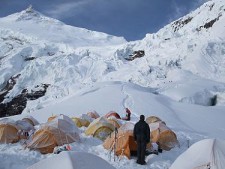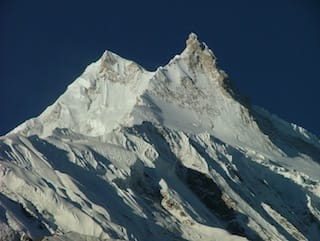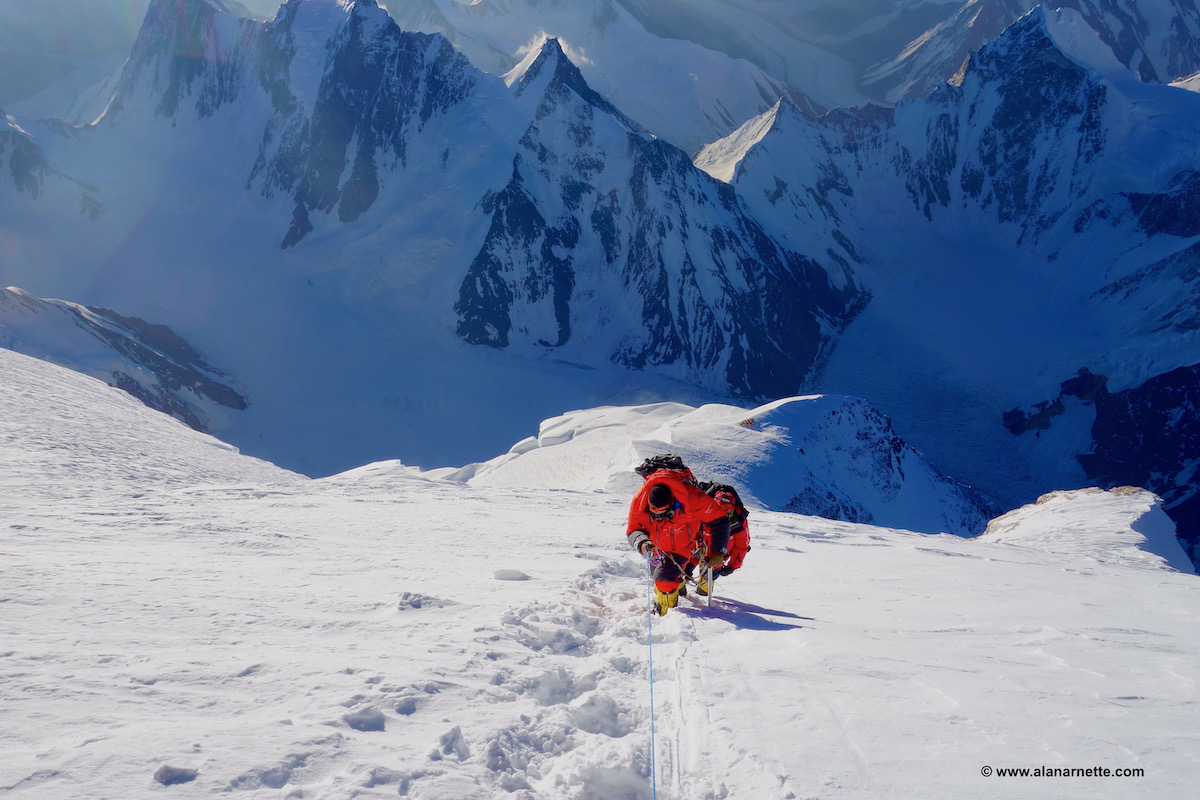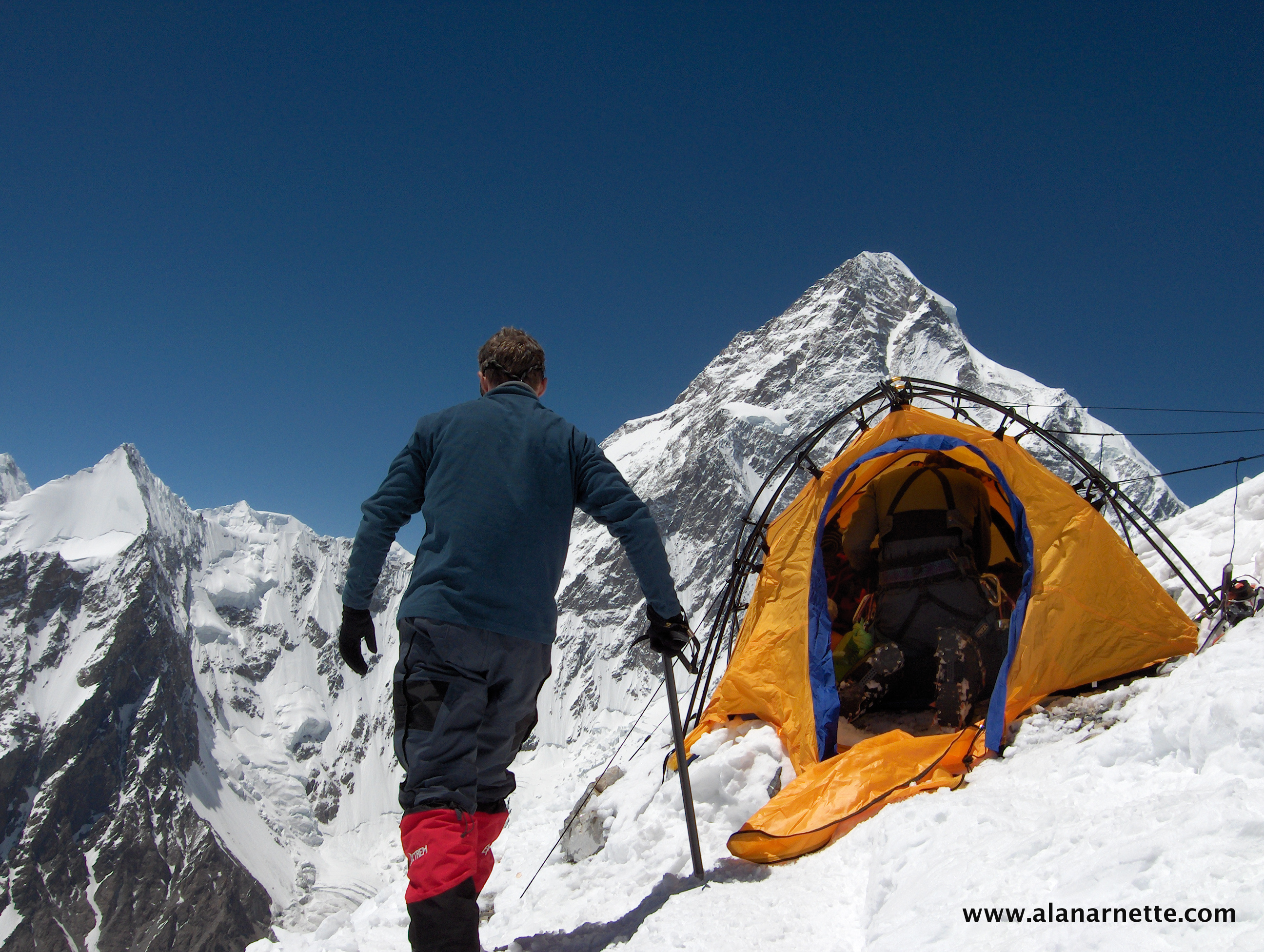In the autumn of 2015, some of the world’s 8000 meter guides stopped their Manaslu expeditions due to risks that crossed their comfort zone but others continued and summited. One person died and another had to be rescued. Why do some stop, others continue and why did one person die?
Manaslu, the world’s 8th highest peak at 26,759’/8156m has become a solid choice for those wanting to get experience on an 8000 meter mountain. It is located in Nepal about 40 miles east of Annapurna, 150 miles west of Everest and 80 miles northwest of Kathmandu. Manaslu is accessible, the route is usually straight forward, albeit with a few technical sections, and has a good track record for summit success.
Through 2013, Manaslu had seen 903 summits. But it has a history of avalanches and deaths. In 2012, 11 climbers were killed by an avalanche that hit directly on Camp 3 where many teams were sleeping. In 1972 15 members of a South Korean expedition were killed by an avalanche, 10 were tragically Sherpa. In total, 79 people have died on Manaslu.
2015 Earthquake
In 2015, the Chinese had closed Tibet to climbing since the April Nepal earthquake had damaged many roads in the region and, perhaps, made climbing too dangerous. This created a problem for many commercial teams who offered autumn climbs of Cho Oyu and Shishapangma each year thus they switched to Manaslu. 106 climbers were registered to climb in 2015.

Fixing the Mountain
Two commercial teams have been going to Manaslu since 2008, Russel Brice’s Himalayan Experience aka Himex and Phil Crampton’s Altitude Junkies (AJ). Each year, they have taken the lead of establishing the route with fixed ropes and ladders and coordinating with all the other teams who were content to let them take the lead and follow later. For this, all the climbers were asked to pay around $150 each for ropes, anchors and labor.
Another well respected, long time Manaslu commercial team, Adventure Consultants switched from Cho Oyu and was on the mountain with their MD, Guy Cotter. This was their third season there. Other teams who had switched from Cho Oyu included SummitClimb, Amical and Seven Summits Treks.

Mixed Weather
The season began with unusually good weather. I know from personal experience having summited Manaslu in 2013, the region in early autumn still gets a lot of monsoonal rain and base camp can receive several feet of snow at one time. In early September, the AJ and Himex Sherpas made good progress fixing the route to Camp 2 thus allowing climbers from all teams to get a jump on the acclimatization programs.
By September, the weather took a turn for the worse. Heavy snow, high winds pummeled the upper mountain and base camp was hit with snow and rain. The bad weather continued for a week with a few small breaks but another huge storm was on the way. Teams used the breaks to make quick trips to Camp 2 but no one had made it higher when the next storm hit.
By late September AJ had put in 33 man days to fix ropes, Himex 31 and Seven Summits Treks, 7. Perhaps an omen, a Himex Sherpa fell through a snow bridge into a crevasse and was evacuated to Kathmandu. Some leaders started to worry that Manaslu was too dangerous to climb this year.
Open Crevasses, Near Misses
This was not an unusual weather pattern for Manaslu, or for many of the world’s highest peaks so teams were prepared to thread the needle and be aggressive. With that philosophy, Himex, AJ left for their summit bid on September 23rd but ran into trouble. Phil Crampton posted this update:
The guys made great progress fixing through the seracs and the blue ice section and then headed for camp four. Unfortunately, this is where things started to go wrong. They encountered waist deep snow, which left them unable to place safe anchors for the fixed rope. Many Sherpas from both the Junkies and Himex were carrying camp four loads and were following the rope fixers when one of these Sherpas fell into a hidden crevasse. The crevasse opened up to 4 meters wide and about 100 meters long, spanning the entire route, basically cutting off the Sherpas ahead of the crevasse.
The Sherpa who fell around 10 meters into the slot was extracted, and then the Sherpas had the task of getting back over the crevasse. They found a way but the snowbridge they crossed was unstable to say the least. Whilst traversing the slot to descend, they triggered a small avalanche that did not harm them but gave them a fright. I am glad to say that the Sherpa who fell into the crevasse was not badly injured and made it down safely to base camp. He is now back in Kathmandu.
The following day another team’s Sherpas were collecting loads from the high point and were exposed to another slab avalanche which luckily missed harming them.
Cancelled Expeditions
Russell Brice made the decision to cancel his expedition:
We have been witnessing the various avalanches and the three different weak layers on our indicator slopes. I am sure that the small bowl that is just below the troublesome crevasse will release as soon as people start climbing this and pull the rope out. That will probably not be such a big deal as it may not be big enough to hurt people. But it this then triggers the bowl above which is also loading at the moment, then there is the possibility of a major calamity. Or like in 2012 if a small serac falls and then triggers these slabs then we for sure will have major problems if there are climbers on the slopes.
I might be wrong, but I really cannot put my Sherpas or members into such a position. If we could see a chance to climb later in the week we would stay, but there is no such chance, and I do not want to be pushed into danger just because of this small weather window.
Soon, Junkies made the same decision. Adventure Consultants’ Guy Cotter told me in an interview:
Overnight 27th September there was very heavy snowfall that forced our Sherpa team at Camp 3 to abandon the camp as the tents were being buried. They made a difficult descent to Camp 2 during the night. I was with my group at Camp 1 intending to depart for Camp 2 in the morning. On the 28th it was still snowing up high (although not at Camp 1). We received another forecast that indicated we only had two clear windless days, the 30th , the 1st, and on the 2nd the wind levels were going to increase to unclimbable levels. After several hours of discussion that morning of the 28th with my fellow guide, Matty Chessor, we concluded that we really wanted to have a full day of fine clear weather for the slope between Camps 3 and 4 to consolidate before we committed our Sherpa team to have to climb it.
The golden rule is that 90% of all avalanches occur during, or the day after a storm and we felt the we needed to stay off that slope on the 30th for it to consolidate and therefore we needed 3 days after the 30th to succeed. A day for carrying loads to establish Camp 4 (1st ), the following day to ascend to Camp 4 (2nd ) with the group, then summit the day after (3rd ). So we needed four clear and calm days and we only had two, the first of which we felt we shouldn’t be on that particular part of the route.
The route below Camp 4 is the most exposed on the entire route and even a small avalanche would have dire consequences. The snow pack on this section of the route prior to this snowfall consisted of chest-deep faceted snow and the potential of newly loaded snow to release was high. It made no sense to consider going onto this slope the day after the storm so we were left with no rational choice but to abandon the summit attempt.

Wait, See and Go
But not all the teams agreed and many stayed at Base Camp holding out for the window around October 1st. I asked one of the leaders working with Seven Summits Treks and a former guide for SummitClimb, Arnold Coster, his assessment of the situation as other teams were leaving:
We had three different weather forecast predicting good weather for 29-30-1st and even further in October when we left Base Camp. The weather forecast was a local forecast from Tribuvan Int. Airport, Gary Kabler from Austria and Meteo Test Switserland. T hey all where pretty similar except slight variations in wind speeds
In stark contrast to the views of Himex, AJ and AC, Costner told me when asked if avalanche and crevasse conditions were too dangerous to go for a summit push:
No! I never seen such good conditions on Manaslu! The snow was very consolidated and hard, probably from the strong winds and sunny weather the previous days. After the 25th the weather cleared, but the wind stayed strong until the 28th afternoon.
There where rumors off a big uncrossable crevasse, so we decided to carry up two ladder also. When our fixing group arrived at the spot where the crevasse should have been there was nothing major to be found and just left the ladder in the snow.
Our first summit group summited on the 30th; they broke trail and fixed 300m off rope at the very end towards the summit. I went up early the next day, summited at 5 am and fixed an other 150m of rope on my descent. By that time other groups where just starting to climb the more angled slopes, just after the plateau.
80 Summits
On September 31st and October 1st around 80 climbers summited Manaslu. One of those was Daniel Trevena who was on the SummitClimb permit after that team switched from Cho Oyu. Dan Mazur, SummitClimb’s owner, was guiding a few members and had several more on a basic permit which provided basecamp meals and sleeping tents according to their website. He had teamed with Seven Summits Treks to provide the basic services.
Trevena described preparing to leave for his summit bid this way:
Weather was super volatile and unpredictable. Lots of wind, lots of snow. Most of the major parties pulled out by the end of September citing bad weather – Himex, AC, Altitude Junkies, Kobler, etc… However our base camp was the cheap nepali one (seven summits), and we were all prepared to stay… So the final climb was quite opportunistic. I went up in bad weather so that I could position myself for a summit window if it came. Spent a few nights holding the walls up on my little BD firstlight tent, as the wind and snow came through C2-3. However this was a good thing. I was safe – had enough warm gear, food and fuel, and knew the front would be blowing all the recent fresh snow off the top, reducing the avalanche risk up high, and hopefully allowing someone to fix the route.
As they approached the summit, they improvised according to Trevena:
So we all left C4 together about 2am on the 30th… The weather was perfect… There was not enough rope to fix the route, so most of it was solo’ed. Those that had personal sherpa roped up with them. The few steep pitches were fixed by the sherpa, and then the rope either cut or pulled up to use again higher up. Two sherpa fixed the final (technical) pitch to the summit and the Ecuadorian and I were first to follow on top. It was unreal, and I felt great, but I didn’t stay long, as I needed to get down while I was feeling strong. Man I’m glad I did. By the time I got back to C4 I was shattered – it was super hot and I was quite tired and dehydrated.
One Death and One Rescue
Zoltan Benedek was on the SummitClimb permit and died after making the summit. Another SummitClimb member, Jean-Luc Brémond had to be rescued from Camp 3 by helicopter, the highest ever on Manaslu. Both were climbing independently on October 1, 2015.
Trevena said he saw Austrian Zoltan Benedek heading higher:
When I had passed them on my way down between C3-4 they both looked like shit. Coughing blood. I stopped and talked for about 15min and told them again they should descend. They were both continuing up, so I gave them some medications for HACE/HAPE and told them what to do, then continued my descent. So you can imagine the next day when we’d heard not much from them we were pretty worried. Eventually someone radioed that they’d made the summit quite late that day, and were at C4 (7500m).
According to Costner, Benedek was strong and doing well but problems developed as he reached High Camp:
He was basically in the same Base Camp, although in a different dining tent. Also I talked with him in Camp 3 & 4 and when I was coming down from the summit.
Zoltan was climbing together with Jean Luc another base camp only member from Dan Mazur’s team. They decided to go up a little earlier as us, because in the earlier weather forecast there was a small chance the weather would improve on the 28th and give them a chance to climb to C4 on that day. Later this didn’t happen and they hold off in C2 already and spend an extra night there.
Zoltan was heaving a bad cough in C3 and he came to me to ask for some medicine. I gave him some cough medicine and told him to take it easy. I also told him there is still enough time to go down and try after a few days again, but he said he was fine and wanted to go to C4 the next day. The next day he and Jean – luc arrived in C4 in a good time and carrying all their own gear. I talked with him in C4 a bit, but he seemed ok. Also I talked with him again around 7am in the morning on his summit push when I came down from the summit. Besides him having a bad cold I didnt notice anything strange with him and he summited in about 2:45hr from C4 without O2!
I reached out to Dan Mazur to understand what happened but Mazur did not respond. Costner continued with his observations:
One of SummitClimb’s Sherpa’s urged him to go down and offered him help to carry his stuff down. Zoltan was very clear about this: he didn’t want any help or support! Also he offered him emergency oxygen for the night, but that was also refused by Zoltan and he send the Sherpa away
Later in the morning Jean-Luc was helped by the Amical and Czech team; the Amical team gave him oxygen & Dex (Czech didnt have any), he was also in a bad state. By that time Zoltan was already dead……….we send a rescue team up for Jean-Luc, they carried him down to C3 where he was picked up by Helicopter. Two days later another rescue team carried down Zoltans body and also flew him (Jean-Luc) down by Heli from C3.
Bulgarian climber, Boyan Petrov gave me this report of his observations of both Benedek and Bremond.
Zoltan was my closest tent neighbor in the Manaslu BC. He seemed quite athletic and experienced in all our talks, which we had. I met him for the last time on 30.09. at about 300m from C4. He looks very tired but still moving.
On 1.10 he climbed Manaslu without O2 and sherpas (I am not sure about this!) and went back to C4 late that day together with the french Jean-Luc Brémond. Both were very exhausted from the climb.
At night, Zoltan died in his sleep (most probably due to pulmonary edema+ exhaustion) and Jean Luc woke up in a very bad condition. The sherpas who were nearby put him on oxygen in the morning of 2.10. Then they called BC and Dawa Sherpa from the Seven Summit’s team initiated a heli evacuation action.
Meanwhile, the sherpas assisted Jean-Luc and slowly brought him down to C3 at 6900m. A helicopter came in the early afternoon and successfully took him down to Kathmandu. As far as I understood, he lost only several tips of his fingers.The body of Zoltan was taken down to C3 on 3.10 and later that day was evacuated to Kathmandu.
The sherpas told us that Zoltan had bloody sputum already in C3 in the morning before starting for C4 on 30.09. On the summit push, both with the french, they were very very slow.
It is a sad story, both climbers were on the brink of dying but nevertheless decided to push for the summit and only Jean-Luc was lucky to survive afterwards.
Lessons
I think there are multiple takeaways from this year’s Manaslu season. These are my opinions and are intended not to make any judgment on any individual or organization.
Large guide services are more conservative by design.
As we have seen on Everest and now Manaslu, the long time experienced operators tend to be more conservative than the young new companies. A lot of this is related to liability. Many members have sued operators for not getting them to the summit.
The lower price guides based in Nepal or other countries where the litigation laws are not as established, seem not to factor into their business model i.e. pricing, lawsuits, settlement or refunds to maintain satisfied members. This allows for lower prices to their members.
There also comes an expectation of summiting when you climb with a service that has a history of summiting and charges more than the lower costs outfits. SummitClimb charges $7,950 for their basic services while Himex asks $22,000.
But with this expectation and money, comes a different level of service including personal Sherpas, extra gear, better food, more oxygen – in others words the climber is fully supported and all they have to is climb. That in and of itself creates an expectation.
Independent climbers take more risks but still need support
Daniel Trevena captured the thrill of climbing without the 1 – 1 Sherpa support or with a Western Guide like this:
I found myself at Camp 4 on the 29th with a rag-tag mix of other opportunists. There were a few fixing sherpa, 4 members who had personal sherpa, and another 3 of us who were climbing totally independently. One was a guide from Peru. The other an Ecuadorian who is halfway through his 14×8000 project. Both smart climbers and I learned a lot. The spirit at C4 was unreal, and the setting absolutely spectacular. It was everything I wanted about himalayan climbing. There was no “teams”, no ego, no sherpa/guide/member status, just a bunch of 15 guys who all wanted the summit.
To be clear, Dan still used the fixed ropes set up by other team’s Sherpas and ate meals prepared for him at base camp. He carried all his own gear, didn’t use supplemental oxygen and performed well. He is right to be proud of his accomplishment.
Independent, does not mean refusing help
It appears from first hand reports that as Zoltan Benedek got into health trouble, he refused aid due to his preference to climb unassisted. This decision may have cost him his life. This is not uncommon on the high mountains. The famous case of David Sharp’s death on Everest in 2006 was another where a climber was independent, just on a permit with no supplemental oxygen and no Sherpa support. He was incapacitated by the time aid was available to him.
Personal responsibility and experience is key when independent
Perhaps the greatest lesson in all these cases is that each climber, whether independent or fully supported must learn the signs of altitude related sickness – AMS, HAPE, HACE. They must carry the appropriate drugs and know how to use them. And most importantly, they must be willing to turn themselves back when they begin to have problems or are observed by others that they are in trouble.
Operators still have a responsibility even if their members didn’t pay for full service
I have noticed a trend on the 8000 meter mountains of low cost operators dominating the market. They offer a low price and appeal to the independent nature of climbers with the offer of no support, climb on your own and freedom to climb at your own pace. This is fine for the most experienced climbers who truly just need logistics assistance getting on a permit and to base camp. But there are few people who meet this high bar of experience and judgment.
Operators who take your money, still have a role when you get in trouble. In this case Sherpas from multiple teams apparently offered assistance to Benedek and helped to arrange the evacuation of Jean Luc. But the question is why did he get in trouble in the first place?
Arnold Coster made this introspective comment:
Personally I have mixed feeling about this accident; mainly as an outfitter not as a climber. As an outfitter should we allow members to climb unsupported on the mountain? Zoltan made a very clear decision from the beginning to climb unsupported and had plenty off experience to do that; as a climber I totally understand his decision.
Then as an Outfitter it is hard to help these members when they get in trouble and in Zoltans case even refuse any kind off help. Should we force this people down and even use violence to do this? That is what the Sherpa had to do to get Zoltan to down……………
Second Thoughts
As for those who went home early only to watch others make it, Himex climber, Greg Paul summed up his feelings well:
I was satisfied that we gave it our shot and made the correct decision given the observations and information we had at the time. Good leadership and firm decision making is key to a long mountaineering career. Also, if you are a sore loser mountaineering is probably not for you.
My condolences to Zoltan’s family and friends.
Climb On!
Alan
Memories are Everything





3 thoughts on “The Back Story on Manaslu 2015 – Summits, Res, Death”
oftentimes, climbers as well as guides cannot see that circumstance coming, its very important to be mindful of ones own condition while climbing and to know how far to push it, it makes a helluva lot of sense to get out of the situation while you are ahead instead of precipitating it to make it worser. i know both dan mazur and arnold coster personally, i’m sure they did their best, but i guess their best wasnt good enough especially if zoltan wasnt in any mood to receive any help.
Intressting personel summary and log aboat this years bid on this huge mountain.
Thanks !
We need to immediately implement a protocol to force people off the mountain that are not in the proper physical condition to be there. We could use a phrase like “Common Sense”. You could say “Common Sense” to a fellow climber who is pushing and sick/AMS/HAPE and should retreat. Maybe after hearing it from many climbers, they will actually retreat.
Comments are closed.